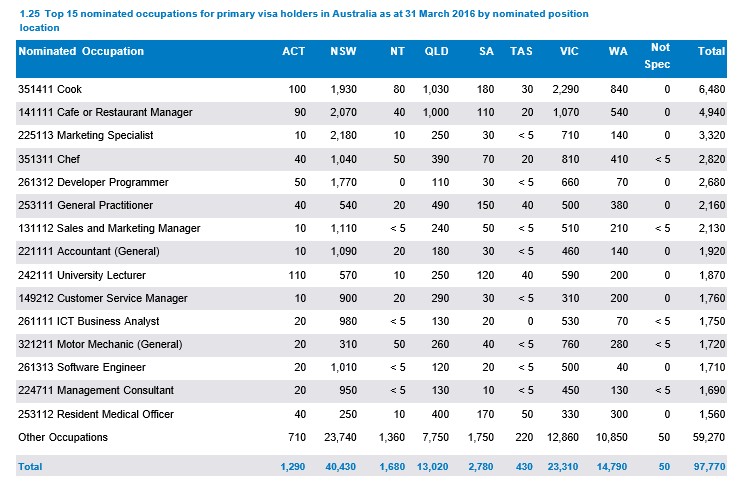457 visas were initially introduced so that companies that could not source “skilled” labour locally, due to shortages, could instead employ foreign workers on a “temporary” basis in order to fill specific roles. They were designed as a short-term stop-gap at a time (the mining boom) when certain labour was genuinely scarce.
However, since their initial introduction we have seen the whole 457 visa system get perverted.
Exemptions from labour market testing have grown from around 20% initially to the outrageous level of around 80% currently.
Exemptions were originally to be granted for clearly defined skills shortages as identified by the then DEEWR (now Department of Employment), such as for doctors in rural areas and for short term skill-specific undertakings (e.g: Asian chef’s for expo’s, etc). Instead we now have Australia’s pubs importing kitchen hands on 457’s in significant numbers with government approval. Most of these jobs could be filled locally with a little bit of training.
457 visas holders residing in Australia also blew-out to around 200,000 (both primary and secondary), with many of these working in professions that are not consider to be particularly “skilled”, in short supply, or critical to the economy, such as cooks/chefs, cafe/restaurant staff, and customer service (see next table).

Not surprisingly then, the 457 visa system was found by a recent Senate Committee to be “not sufficiently responsive either to higher levels of unemployment, or to labour market changes in specific skilled occupations”.
Yesterday, The Australian published the results of an FOI request which revealed that government officials have refused to cull the Skilled Occupation List because they don’t want Australians to think 457 visas are being used to manage any short-term shortage of workers, despite this being their initial purpose:
Immigration Minister Peter Dutton on Sunday raised the prospect of more jobs being removed from the list, amid a debate over the role 457 visas. The documents show the government has traditionally taken a conservative, long-term approach.
The Australian has previously revealed the Department of Health wanted 41 medical occupations, including GPs and surgeons, removed from the 2016-2017 list because local graduates might struggle to find training places or jobs so long as the immigration pathway remains open. Those recommendations were largely ignored or overruled, by an interdepartmental committee and then the responsible Department of Education and Training, in the annual review, with the government offering no explanations.
Briefing notes for Vocational Education and Skills Minister Scott Ryan, obtained under Freedom of Information laws, emphasise that since its establishment in 2010 “the list has remained relatively stable with only a few occupations being added or removed in any given year”.
“Major changes to the list from year to year would signal that it is being used to manage short-term labour market fluctuations,” the briefs state.
Other aspects of that advice — including all instances where stakeholders disagreed with the recommendations — have been withheld from release under FOI for fear of compromising the review process and undermining the labour market.
As noted last week by Joanna Howe, Senior Lecturer in Law at University of Adelaide:
The mechanism for identifying who can apply for these [457] visas is the Consolidated Sponsored Occupations List. This is a list that has no requirement that the occupation be in demand in the Australian labour market. It includes more than 600 occupations, most of which are not in shortage. So long as an employer nominates an overseas worker to perform a job on this list, then the occupation is deemed to be in need.
Nursing, teaching, engineering and law are all on this list, and are also occupations where Australian graduates are struggling to enter the labour market.
This means the 457 visa can be used by employers who wish to access foreign labour for an ulterior motive.
The recent Senate Report entitled A National Disgrace: The Exploitation of Temporary Work Visa Holders also identified massive flaws in the Consolidated Sponsored Occupations List, which it saw as ad hoc and ineffective. Accordingly, the report recommended implementation of more rigorous, independent, evidence-based, and transparent processes for determining the List, along with more stringent labour market testing.
With the latest Department of Employment skills shortages report finding that Australia’s skills shortage “remains low by historical standards”, in addition to the massive labour underutilisation present across Australia, there is no need for the large-scale use of 457 visas.
The whole visa system must, therefore, be pared-back, including via:
- increasing the minimum income threshold for 457 visa holders and indexing them to ordinary earnings growth;
- implementing a more rigorous, independent, evidence-based, and transparent processes for determining the Consolidated Sponsored Occupations List;
- implementing stringent labour market testing of all 457 visa nominations to ensure that employers employ locals first wherever possible; and
- explicitly prohibiting the replacement of local workers by 457 visa workers.
The 457 visa farce has dragged on far too long. It’s time for fundamental reform of the system.

